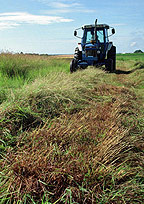
On Wednesday of this past week, the Department of Energy (DOE) released a report — first prepared and published in the summer of 2007 by Lynn Wright — titled Historical Perspective on How and Why Switchgrass was Selected as a “Model” High-Potential Energy Crop. The report is a detailed, chronological look at how the United States came to focus on switchgrass as a potential fuel source. It reveals how an unheard-of crop came to be mentioned by President Bush in his 2006 State of the Union address and has since become a symbol of the biofuel revolution.
 Switchgrass may have seemed to come out of nowhere in that speech, but Wright shows it has interested alternative-energy analysts for a surprisingly long time. DOE started developing biomass resources as early as 1976 when its Biomass Systems Branch funded several studies on sugar crops, agricultural residues, wood energy farms, grains and grasses, and aquatic plant production. In 1977, the department co-funded a field study with the Department of Agriculture on woody crops, sugar cane, and tropical grasses. This led the Energy Department to established its own energy crop research effort.
Switchgrass may have seemed to come out of nowhere in that speech, but Wright shows it has interested alternative-energy analysts for a surprisingly long time. DOE started developing biomass resources as early as 1976 when its Biomass Systems Branch funded several studies on sugar crops, agricultural residues, wood energy farms, grains and grasses, and aquatic plant production. In 1977, the department co-funded a field study with the Department of Agriculture on woody crops, sugar cane, and tropical grasses. This led the Energy Department to established its own energy crop research effort.
Wright points to the “screening trials” funded by DOE in the late 1980s and early 1990s as a key development in the department’s efforts to assess the potential of so-called energy crops. The agency funded research projects looking at 34 species on 31 different sites spread over seven states in crop-producing regions of the U.S. The research was conducted by six universities and one private company.
In 1984, the Herbaceous Energy Crops Program was launched to focus on “grass and legume herbage” that could be grown in the Southeast and Midwest states. The focus was on these sources because a government report had identified them “as second in size only to wood.”
Wright finds that while “several species were identified as having merit for further development,” a majority of the groups conducting research identified switchgrass as “having high priority for further development.”
The results of these trials, along with assessments by Oak Ridge National Laboratory’s Biofuels Feedstock Development Program (and funding limitations — of course), led to a decision by DOE in 1991 to invest in switchgrass as a “model” or “prototype” bioenergy crop.
In a 1992 report, the Biofuels Feedstock Development Program justified the decision to focus on switchgrass, saying that the annual yields from these crops on test sites were “well above the production level considered prerequisite for a successful biofuels industry.” The potential land base for switchgrass was also believed to be large, namely the 48 million acres of marginal land that has severe restrictions for conventional crop production:
As a widely adapted endemic species of the tall grass prairies, switchgrass has demonstrated a capacity for high yields on relative poor quality sites…. Research at Virginia Polytechnic Institute and State University has shown that … switchgrass has a significant capacity to improve soil quality by sequestering carbon belowground. Improved erosion control, reduced fertilizer and pesticide requirements and a capacity for providing wildlife cover are additional positive environmental attributes. An important quality of switchgrass is its strong potential appeal to landowners, for whom cultivation of a perennial crop that can be grown, harvested, and stored with conventional equipment represents an easy interface with current agricultural practices.
In short, part of the potential promise of switchgrass was that it could be produced using land in danger of erosion — and could even help protect the soil.
Following the decision to focus on switchgrass in 1991, the Energy Department kicked off a decade-long study of switchgrass at ten institutions.
Fast forward to 2007: “It is very apparent that while switchgrass may not be a perfect energy crop (and there may not be a perfect crop),” Wright says, it is clear today that it is “one of the more sustainable feedstocks for the production of renewable alternative fuels in the U.S.”
Wright points out that while the Energy Department decided to focus on switchgrass because it was an “environmentally and economically sound choice for many parts of the country, it was not a clear winner in all locations.” Wright also points that research conducted specifically to improve switchgrass as a “model biomass energy crop during the 1990s has been very successful in improving its potential as a dedicated biomass energy crop.”
In 2006, a paper published in Science brought attention to “mixed grassland biomass” as an environmentally preferable, low-cost alternative resource for bioenergy, Wright notes. The paper focused on the energy input/output comparisons between growing corn grain for ethanol, soybeans for biodiesel, and grassland crops for biomass electric, biomass ethanol, or biomass synfuels. The grassland-crop-based systems were shown to have significantly higher net energy balances than either the corn-grain-to-ethanol or soybeans-to-biodiesel systems.
